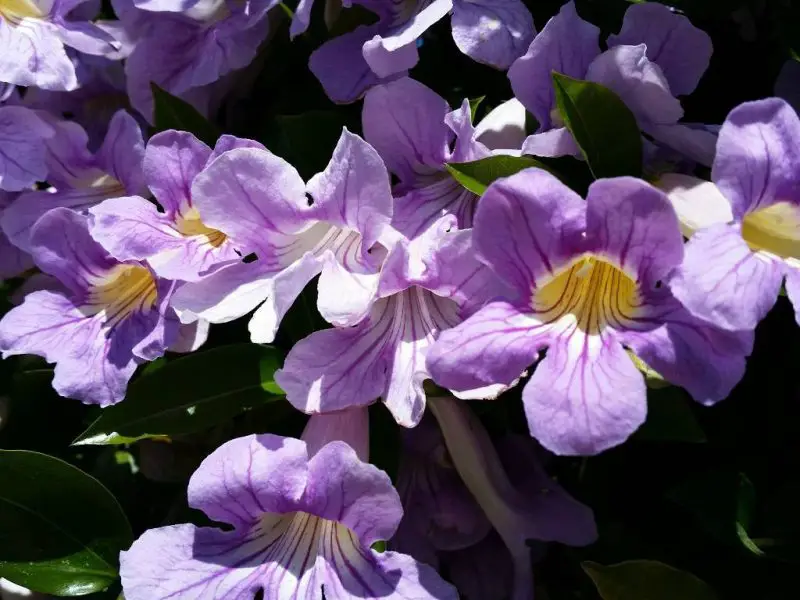Trumpet vines are vigorous climbing plants known for their vibrant, trumpet-shaped flowers. These fast-growing vines can quickly transform fences, arbors, and trellises into colorful displays that attract hummingbirds, bees, and butterflies. Understanding how to grow trumpet vine effectively ensures that your garden enjoys long-lasting blooms and dense foliage that enhances visual appeal.
Growing trumpet vines requires attention to sunlight, soil, and water, along with seasonal care practices like pruning and fertilization. With proper guidance, gardeners can achieve a spectacular display from spring through fall, creating a lively and inviting outdoor space. This guide provides essential tips to maximize growth, flowering, and overall garden beauty.
Understanding Trumpet Vine and Blooming Cycles

Trumpet vine, or Campsis radicans, is a vigorous climbing perennial. It thrives in heat and full sun. Its woody stems climb by aerial roots. The vine spreads quickly and demands sturdy support. Flowers are trumpet-shaped and vividly colored. Most cultivars display orange, red, or golden tones. Fragrance is light, yet nectar is plentiful. Hummingbirds and bees visit the blooms daily. Growth accelerates in spring as soil warms. New shoots elongate rapidly on sunny structures. Energy moves from roots into expanding foliage. This early phase prepares tissues for later flowering. Understanding these rhythms improves care and expectations.
Blooming follows a seasonal cycle that favors warmth. Bud initiation begins as days lengthen in late spring. Adequate light triggers hormonal signals within shoot tips. Flower clusters develop on new growth each season. Pruning in late winter directs vigor to future flowering wood. Excess nitrogen encourages leaves instead of blossoms. Balanced nutrition keeps growth steady and productive. Peak bloom often arrives in midsummer. In warmer climates it may start earlier. Displays can continue into early autumn. Spent blooms mature into long seed pods. The plant then redirects energy to roots and next year.
Climate strongly shapes the calendar of these events. In USDA zones four through nine, timing varies widely. Cool zones delay bud formation until sustained warmth arrives. Hotter zones offer longer windows of floral color. Young plants may delay blooming for several years. Patience is essential during this juvenile phase. Consistent sun ensures reliable bud development and color. Deep, infrequent watering strengthens roots and resilience. Mulch moderates soil temperatures and retains moisture. Strong supports prevent wind damage and stem breakage. Understanding the cycle helps gardeners plan pruning and care. Seasonal timing matters.
Choosing the Right Location for Trumpet Vine
Trumpet vine thrives best in a spot that offers full sun, as abundant light is the key factor behind its vigorous flowering. Although this climbing vine can adapt to partial shade, limited sunlight often leads to fewer blooms and weaker growth. To achieve the dramatic display of orange-red trumpet-shaped flowers it is known for, choose a location that receives at least six to eight hours of direct sunlight daily.
Equally important is selecting a strong support structure. Trumpet vine grows aggressively, often reaching 30 to 40 feet in length, and its aerial rootlets can cling tightly to walls, fences, or trellises. Because of its weight and invasive growth habit, it is best to provide a durable support such as a sturdy arbor, pergola, or chain-link fence. Avoid planting it directly on wooden siding or delicate structures, as the vine may cause damage over time.
Soil conditions also play a role in the plant’s long-term health. While trumpet vine tolerates a wide range of soils, it performs best in moderately fertile, well-draining ground. Heavy clay soils should be amended with compost to improve aeration and drainage. Once established, trumpet vine can adapt to poor soil and even withstand periods of drought, making it a resilient option for many gardens.
Best Time to Plant Trumpet Vine for Healthy Growth
Trumpet vine thrives when planted at the right time, as proper timing ensures strong root establishment and abundant flowering later. The ideal season to plant trumpet vine is in spring or early fall, when soil is workable and temperatures are mild. Spring planting allows the vine to take advantage of warm weather for rapid growth, while fall planting provides cooler conditions that encourage strong root development before winter. Avoid planting in the peak of summer heat or during winter frost, as extreme conditions can stress young plants.
Before planting, choose a location with full sun exposure, since trumpet vine produces the most flowers with at least six hours of direct sunlight each day. While the plant is adaptable to different soils, it performs best in well-drained, moderately fertile ground. Adding compost before planting improves soil structure and supports vigorous growth. When placing the vine, ensure there is ample space, as it can spread aggressively once established.
Timing also depends on your climate. In colder northern regions, spring planting is preferable to give the plant a long growing season. In warmer southern areas, early fall is an excellent choice, allowing roots to settle during cooler months. Proper timing not only reduces transplant stress but also lays the foundation for a healthier, more manageable trumpet vine in the long term.
Soil Preparation and Planting Tips
Trumpet vine grows best in well-draining, moderately fertile soil. Preparing the soil properly ensures healthy root development and long-lasting blooms. Before planting, clear the area of weeds, rocks, and debris. Loosen the soil to a depth of at least twelve inches to help roots establish quickly. Adding organic matter, such as compost or well-rotted manure, improves soil structure and provides essential nutrients for vigorous growth.
Choosing the correct planting depth is equally important. The root ball should sit slightly above the surrounding soil to prevent water accumulation around the base. Backfill the hole with enriched soil, firming gently to remove air pockets. Water thoroughly after planting to settle the soil and encourage immediate root contact. Mulching around the base helps retain moisture and regulate soil temperature while suppressing weed growth.
Timing and spacing also influence success. Plant trumpet vine in spring or early fall when temperatures are mild, allowing roots to establish before extreme weather. Provide ample space for growth, as this vine spreads aggressively and can reach thirty to forty feet over time. Position the plant near a sturdy support such as a trellis, fence, or arbor to guide its vertical growth. Proper soil preparation, planting depth, and spacing ensure the vine thrives, producing vibrant, long-lasting blooms in the seasons ahead.
Watering Needs for Continuous Blooms
Trumpet vine requires regular watering during its establishment phase. Newly planted vines need consistent moisture to develop strong roots. Water deeply once or twice a week, depending on soil type and local rainfall. Shallow, frequent watering encourages weak surface roots, which can reduce flowering and plant resilience. Adequate water early on ensures the vine grows vigorously and produces abundant trumpet-shaped blooms.
Once established, trumpet vine becomes relatively drought-tolerant. Mature plants can survive with less frequent watering, though supplemental irrigation during dry spells promotes prolonged flowering. Deep watering every two to three weeks is generally sufficient for most climates. Overwatering, however, can lead to root rot or overly lush foliage with fewer flowers. Observing the soil and adjusting watering schedules is essential for plant health.
Container-grown trumpet vines need closer attention, as soil dries faster in pots. Water until it runs through drainage holes, ensuring roots receive adequate moisture. Mulching around the base of in-ground plants helps retain water and maintain soil temperature. Proper irrigation practices combined with good sunlight and soil conditions allow trumpet vine to bloom continuously throughout summer, rewarding gardeners with vibrant flowers and sustained visual impact.
Fertilizing for Growth
Trumpet vine benefits from balanced fertilization to support healthy growth and abundant blooms. In early spring, applying a slow-release fertilizer rich in phosphorus encourages strong root development and future flower production. Avoid high-nitrogen fertilizers, as they promote excessive leafy growth at the expense of blossoms. Proper nutrient balance ensures that the plant produces vibrant trumpet-shaped flowers without becoming overly vegetative.
Fertilization should also consider soil quality. Before applying any fertilizer, test the soil to determine nutrient deficiencies. Incorporating compost or organic matter improves soil structure and supplies essential nutrients gradually. Fertilizing in combination with organic amendments reduces the risk of overfeeding and supports sustainable growth. For container-grown trumpet vines, nutrients may leach faster due to frequent watering, so supplemental feeding during the growing season is necessary.
During the active growing season, light applications of fertilizer every six to eight weeks help maintain vigorous flowering. Avoid fertilizing late in the season, as this can stimulate new growth that may not harden before winter. Consistent, measured fertilization encourages long-lasting blooms and a stronger plant overall. By providing the right nutrients at the right time, gardeners ensure trumpet vines grow healthily, covering trellises and fences with spectacular flowers year after year.
Pruning Techniques to Enhance Blooming
Pruning is essential for trumpet vine to maintain shape and encourage prolific flowering. This vigorous climber can become unruly if left unchecked, producing excessive foliage with fewer blooms. The best time to prune is late winter or early spring, before new growth begins. Removing dead, weak, or overcrowded branches allows sunlight to penetrate the canopy and directs the plant’s energy toward flower production.
Selective pruning also stimulates growth on flowering wood. Cut back long, unproductive shoots to maintain structure and balance. Avoid removing too many healthy stems at once, as this may reduce bloom quantity for the coming season. For vines grown on fences or trellises, tie main stems loosely to supports to guide growth and prevent damage. Light summer pruning can remove spent blooms and control excessive growth, extending the visual appeal of flowers.
Pruning also helps manage plant health. By removing damaged or diseased wood, gardeners reduce the risk of fungal infections and pest infestations. Regular pruning improves airflow and light distribution, creating an environment conducive to vigorous flowering. Combined with proper watering, fertilization, and sunlight, pruning ensures trumpet vine produces vibrant, long-lasting blooms that cover trellises, fences, or arbors with stunning orange-red flowers throughout the growing season.
Age of Plant and Blooming Maturity
Trumpet vine requires patience, as young plants often take several years to bloom. In the first two to three years, the plant focuses on establishing strong roots and woody stems. During this juvenile phase, it may produce lush foliage but few flowers. Providing proper care, including adequate sunlight, watering, and fertilization, ensures the plant develops the foundation necessary for future flowering.
Mature trumpet vines, typically over three to five years old, enter their peak blooming phase. By this time, the plant has a well-established root system and ample energy to produce abundant clusters of trumpet-shaped flowers. Gardeners should continue regular pruning and maintenance to direct energy to flowering wood and maintain a healthy, attractive shape. Encouraging flowering at this stage maximizes the visual impact of the vine.
Environmental conditions can influence the age of maturity. In cooler climates, trumpet vines may take longer to reach peak blooming, while warmer regions accelerate development. Providing optimal conditions, such as full sun, well-draining soil, and balanced nutrients, supports earlier flowering. Patience, consistent care, and understanding the plant’s natural growth cycle allow gardeners to enjoy spectacular displays of trumpet vine blooms over many seasons, rewarding long-term commitment with vibrant, colorful coverage.
Pests and Diseases Affecting Blooms
Common Insect Pests
Trumpet vine can attract various insect pests that affect flowering and overall plant health. Aphids and scale insects are common culprits, feeding on sap and weakening the plant. Heavy infestations can stunt growth and reduce flower production. Early detection and treatment are essential to protect blooms. Gardeners should inspect leaves and stems regularly, looking for sticky residue or discolored foliage. Treating with insecticidal soap or horticultural oils can control infestations without harming beneficial insects.
Other pests, such as spider mites, thrive in hot, dry conditions. These tiny insects cause stippling on leaves and can lead to premature leaf drop. Maintaining adequate watering, mulching, and proper air circulation reduces the risk of severe infestations. Integrated pest management, including encouraging natural predators like ladybugs, helps keep insect populations in check and ensures healthy trumpet vine blooms.
Fungal and Viral Diseases
Trumpet vine is susceptible to several fungal and viral diseases that can significantly impact flowering. Powdery mildew is among the most common issues, appearing as a white, powdery coating on leaves and stems. This fungal infection can weaken the plant, reduce photosynthesis, and decrease bloom quality if left untreated. Early detection is crucial. Applying fungicides or natural remedies, such as neem oil or sulfur-based treatments, helps control mildew and maintain plant vigor. Regular monitoring during warm, humid periods is essential to prevent outbreaks.
Other diseases include canker and root rot, which primarily affect older or stressed plants. Canker manifests as sunken lesions on stems and branches, potentially causing dieback and reducing flower production. Root rot results from poorly drained soil, leading to soft, discolored roots and eventual plant decline. Preventive measures include improving soil drainage, avoiding excessive watering, and promptly pruning diseased or damaged areas. Implementing these strategies ensures trumpet vines maintain robust growth and vibrant, consistent blooms throughout the growing season. Combining early detection, proper care, and timely treatment creates the best conditions for disease-free flowering and overall plant health.
Seasonal Tips for Stunning Color
Spring Care for Trumpet Vines
Spring is the season for active growth and preparing trumpet vine for abundant blooms. Start by pruning dead, damaged, or weak branches. This encourages new shoots on flowering wood and improves air circulation. Removing crowded stems allows sunlight to reach inner branches, stimulating healthy bud development. Apply a balanced, slow-release fertilizer to supply nutrients needed for root growth and future flowers. Ensure the vine is securely tied to supports like trellises or fences to guide vertical growth and prevent breakage. Mulching around the base retains moisture, protects roots, and stabilizes soil temperature. Check for early signs of pests or disease and remove affected foliage promptly to maintain plant health. By providing consistent spring care, gardeners create optimal conditions for early blooms and a strong start to the flowering season.
Spring attention sets the stage for long-lasting blooms. Healthy new growth produces more vibrant flowers in summer. Regular inspections for pests and proper pruning encourage uniform development. With appropriate care, trumpet vine can achieve dense foliage and numerous bright, trumpet-shaped flowers, ensuring a colorful garden display that lasts throughout the growing season.
Summer Care for Maximum Flowers
Summer is peak bloom season for trumpet vine, requiring careful maintenance to maximize flowers. Deep, consistent watering supports vigorous growth and prevents stress during hot, dry periods. Shallow or irregular watering can weaken roots and reduce flowering. Deadhead spent blooms regularly to stimulate new flower production and maintain a vibrant appearance. Monitor for common pests, including aphids, spider mites, and scale insects, and treat infestations promptly with natural solutions or insecticidal soap. Light pruning controls excessive growth while preserving flowering wood, ensuring the plant maintains shape and aesthetics. Provide ample sunlight, as it is essential for the development of bright, trumpet-shaped flowers.
Proper summer care prolongs flowering and enhances garden beauty. Adequate sunlight, irrigation, and pest management ensure continuous bloom. This attention during the growing season keeps the vine healthy, colorful, and visually striking. Consistency in care creates a flourishing display that attracts pollinators and maintains vibrant foliage throughout the season.
Fall Care to Prepare for Dormancy
Fall signals slowing growth and the need to prepare trumpet vine for winter dormancy. Reduce watering gradually to prevent root rot, and avoid late-season fertilization that encourages tender, frost-sensitive growth. Cut back long, tangled shoots to maintain plant structure and prevent overcrowding. Remove fallen leaves and debris to reduce pest and disease risks. Apply mulch around the base to protect roots from cold temperatures and retain soil moisture. This preparation ensures the plant remains healthy during colder months and emerges strong in spring.
Fall care also minimizes damage from winter conditions and sets the stage for vigorous flowering next season. By pruning, cleaning, and protecting the root zone, gardeners maintain plant health and support long-term bloom consistency. Proper attention during this period ensures trumpet vine produces abundant, colorful flowers year after year, sustaining garden beauty across seasons.
How to Extend the Blooming Season
Extending the blooming season of trumpet vine requires careful management of environmental factors and plant care. One of the most effective methods is consistent deadheading. Removing spent flowers encourages the plant to produce new buds and prolongs the display of vibrant, trumpet-shaped blooms. Regular observation is necessary to identify wilted or dying flowers early and maintain a visually appealing garden throughout the season. Deadheading also reduces the formation of seeds, which can divert energy away from flowering.
Another important factor is proper watering and nutrient management. During extended heat or drought periods, deep irrigation ensures that roots remain hydrated, supporting ongoing flower production. Balanced fertilization with phosphorus-rich fertilizers encourages bud formation and sustained blooming. Avoid excessive nitrogen, which promotes leafy growth over flowers. Maintaining soil health through compost and organic matter enhances nutrient availability, further supporting flower longevity.
Pruning strategically throughout the growing season also helps extend blooming. Lightly trimming overly long shoots encourages new growth on flowering wood without removing too many blooms. Positioning the vine in optimal sunlight and ensuring good airflow prevents fungal diseases that can prematurely reduce flower production. By combining deadheading, careful watering, nutrient management, and strategic pruning, gardeners can enjoy a longer and more vibrant trumpet vine flowering season, creating lasting color and visual impact in the garden from late spring through fall.
Common Blooming Problems and Solutions
Insufficient Sunlight
Trumpet vine requires full sun for optimal flowering. When planted in shaded areas, it often produces lush foliage but few flowers. Lack of sunlight weakens the plant’s ability to develop flower buds, resulting in sparse or delayed blooms. To solve this problem, relocate the vine to a sunnier spot if possible. Prune surrounding trees or shrubs that may be blocking sunlight to increase exposure. Ensuring at least six to eight hours of direct sunlight daily promotes robust flowering.
Additionally, for container-grown trumpet vines, rotate pots to maximize light exposure throughout the day. Providing adequate sunlight improves photosynthesis, which fuels flower development. Monitoring plant growth and adjusting positioning or supports can enhance light penetration, ensuring even bud formation. With proper sun management, trumpet vine can produce a vibrant display of trumpet-shaped flowers, attracting pollinators and creating visual interest in the garden.
Overwatering or Poor Drainage
Excess water can lead to root rot and reduced flowering. Trumpet vine prefers well-draining soil, and waterlogged conditions can stress the plant. Signs include yellowing leaves, wilting, or reduced bloom production. Improve soil drainage by amending with organic matter or creating raised beds. Deep, infrequent watering encourages strong root development, supporting healthy growth and consistent flowering.
Mulching helps retain moisture while preventing excess water at the base. Avoid overwatering during rainy periods and monitor soil moisture regularly. Ensuring proper irrigation practices promotes vigorous growth and enhances flower quality. Proper drainage prevents fungal diseases that can harm buds and leaves, allowing trumpet vine to produce abundant, long-lasting blooms.
Nutrient Deficiency
A lack of essential nutrients, especially phosphorus, can limit flower formation. Nitrogen-rich fertilizers encourage leafy growth but reduce blooms. Regular soil testing helps identify deficiencies and guides fertilization strategies. Applying a balanced fertilizer or phosphorus-focused formula promotes bud formation and vibrant flowers.
Incorporating compost or organic matter improves soil structure and nutrient availability. Consistent feeding supports sustained flowering and healthy foliage. Monitoring plant response to nutrients allows adjustments for optimal bloom production. Addressing nutrient deficiencies ensures trumpet vine thrives and displays abundant, colorful trumpet-shaped flowers, enhancing garden appeal throughout the season.
Pest Infestations
Insects like aphids, spider mites, and scale can weaken trumpet vine and reduce blooms. Feeding on sap causes leaf discoloration, wilting, and stunted growth. Regular inspections and early intervention are key. Treat infestations with insecticidal soap or natural predators like ladybugs to minimize damage.
Maintaining plant health through proper watering, pruning, and fertilization reduces pest vulnerability. Removing heavily infested leaves prevents spread and preserves energy for flowering. Combining cultural practices and pest control measures ensures trumpet vine remains vigorous, producing continuous and abundant blooms across the growing season.
Benefits of Trumpet Vine Blooms
Trumpet vine blooms provide more than just visual appeal. Their vibrant orange-red flowers attract pollinators such as hummingbirds, bees, and butterflies. This interaction supports local ecosystems and encourages biodiversity in the garden. The long, tubular flowers are particularly appealing to hummingbirds, which feed on nectar and help with pollination. By attracting these species, trumpet vine contributes to the overall health of surrounding plants and enhances ecological balance.
In addition to ecological benefits, trumpet vine flowers improve aesthetic value. The bright, trumpet-shaped blossoms create striking focal points on fences, arbors, trellises, and walls. Their vivid colors and long-lasting display enhance garden design and visual interest. Landscaping with trumpet vine can transform plain structures into dynamic, colorful features. The plant’s vigorous growth and abundant blooms provide coverage, privacy, and a lush, tropical feel to outdoor spaces.
The blooms also offer seasonal enjoyment. Flowering typically occurs from late spring through fall, providing extended periods of color and garden vibrancy. Their presence can improve mood and attract wildlife observers. Combined with low-maintenance growth and adaptability to various soil types, trumpet vine is both practical and beautiful. By planting trumpet vine, gardeners gain ecological benefits, aesthetic enhancement, and continuous seasonal enjoyment, making it a valuable addition to any landscape.
Landscaping Ideas with Trumpet Vines
Using Trumpet Vines on Fences
Trumpet vines are excellent for covering fences and transforming plain structures into colorful backdrops. Their vigorous climbing habit allows rapid coverage, producing lush foliage and bright, trumpet-shaped flowers. By training the vine along a fence, gardeners can create privacy and block unsightly views. Regular pruning maintains the desired shape and encourages more blooms. Position the fence in full sun to ensure maximum flowering, as shaded areas may produce fewer blossoms.
Incorporating trumpet vine on fences enhances garden depth and structure. Mixing it with other plants like perennials or flowering shrubs creates a layered look and continuous color. The combination of foliage and vibrant blooms attracts pollinators, increasing garden biodiversity and supporting local ecosystems.
Growing Trumpet Vines on Arbors
Arbors provide ideal support for trumpet vines. The sturdy structure allows vines to climb and cascade, producing a dramatic floral display. Position arbors in sunny areas to ensure consistent blooming. Secure stems to prevent breakage, and prune lightly to control growth. Cascading flowers create a natural canopy, enhancing the outdoor space with color and texture.
Using arbors also allows gardeners to highlight pathways or entrances, creating focal points in landscape design. Paired with companion plants, trumpet vines add visual interest and dynamic vertical appeal, elevating garden aesthetics.
Combining Trumpet Vines with Other Plants
Trumpet vines pair well with other perennials and shrubs, providing contrast and visual balance. Their bright flowers stand out against green foliage, complementing surrounding plants. Match bloom times with companion species to maintain continuous color throughout the season.
Integrating trumpet vines into mixed plantings enhances biodiversity and attracts pollinators. Careful planning of spacing, sunlight, and water needs ensures harmonious growth. This strategy results in a vibrant, diverse garden with extended visual appeal and ecological benefits.






